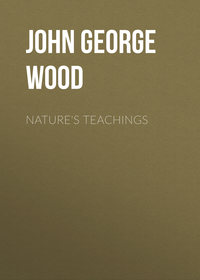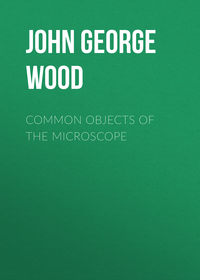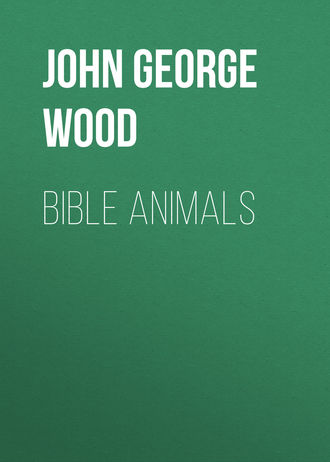 полная версия
полная версияBible Animals
In the meantime, guided by the float, the hunter follows the course of the animal, and, as soon as it comes within reach of his weapon, drives another spear into it, and so proceeds until the animal dies from loss of blood. The modern hunters never throw a second harpoon unless the one already fixed gives way, mainly employing a spear to inflict the last wounds. But if we may judge from this painting, the Egyptian hunter attached a new rope with every cast of his weapon, and, when the hippopotamus became weak from its wounds, gathered up the ropes and came to close quarters.
In the bow of the boat is the hunter's assistant, armed with a rope made lasso-wise into a noose, which he is throwing over the head of the hippopotamus, whose attitude and expression show evidently, in spite of the rudeness of the drawing, the impotent anger of the weakened animal.
Behind the hippopotamus are the tall and dense reeds and papyrus under the shelter of which the animal loves to lie, and on the surface of the water float the beautiful white flowers of the lotus.
In the Egyptian painting, the artist, in spite of the conventionalities to which he was bound, has depicted the whole scene with skill and spirit. The head and open mouth of the hippopotamus are remarkably fine, and show that the artist who drew the animal must have seen it when half mad with pain, and half dead from loss of blood.
The enormous strength of the hippopotamus is shown in verses 16, 18, the last of which passages requires a little explanation. Two different words are used here to express the bones of the animal. The first is derived from a word signifying strength, and means the "strong bones," i.e. those of the legs. These are hollow, and are therefore aptly compared to tubes or pipes of copper. The second term is thought by some Hebraists to refer to the rib-bones, which are solid, and therefore are not likened to tubes, but to bars of iron.
The 23d verse has been translated rather variously. The Authorized Version can be seen by reference to a Bible, and another translation, that of the Jewish Bible, is given on page 319. A third, and perhaps the best rendering of this passage is given by the Rev. W. Drake, in Smith's "Dictionary of the Bible:" "Lo, the river swelleth proudly against him, yet he is not alarmed; he is securely confident though a Jordan burst forth against his mouth."
In all probability reference is here made to the annual rising of the Nile, and the inundations which it causes. In some years, when it rises much above its usual height, the floods become most disastrous. Whole villages are swept away, and scarcely a vestige of the mud-built houses is left; the dead bodies of human beings are seen intermixed with those of cattle, and the whole country is one scene of desolation. Yet the almost amphibious hippopotamus cares nothing for the floods, as long as it can find food, and so, "though the river swelleth proudly against him," he is not alarmed.
From the use of the word "Jordan" in the same verse, it might be thought that the river of Palestine was intended. This, however, is not the case. The word "Jordan" is simply used as a poetical term for any river, and is derived from a Hebrew word which signifies "descending quickly."
We now come to the last verse of this noble description: "He taketh it in with his eyes." These words have also been variously rendered, some translating them as "He receiveth it (i.e. the river) up to his eyes." But the translation which seems to suit the context best is, "Who will take him when in his sight? His nose pierceth through (i.e. detects) snares." Now, this faculty of detecting snares is one of the chief characteristics of the hippopotamus, when it lives near places inhabited by mankind, who are always doing their best to destroy it. In the first place, its body gives them an almost unlimited supply of flesh, the fat is very highly valued for many purposes, the teeth are sold to the ivory-dealers, and the hide is cut up into whips, or khoorbashes.
There is now before me a khoorbash, purchased from a native Egyptian who was beating a servant with it. The whip is identical with that which was used by the ancient Egyptians in urging the Israelites to their tasks, and the scene reminded the traveller so forcibly of the old Scriptural times that he rescued the unfortunate servant, and purchased the khoorbash, which is now in my collection.
Not content with hunting the hippopotamus, the natives contrive various traps, either pitfalls or drop-traps. The former are simply pits dug in the path of the animal, covered with sticks and reeds, and having at the bottom a sharp stake on which the victim is impaled, and so effectually prevented from escaping or damaging the pit by its struggles.
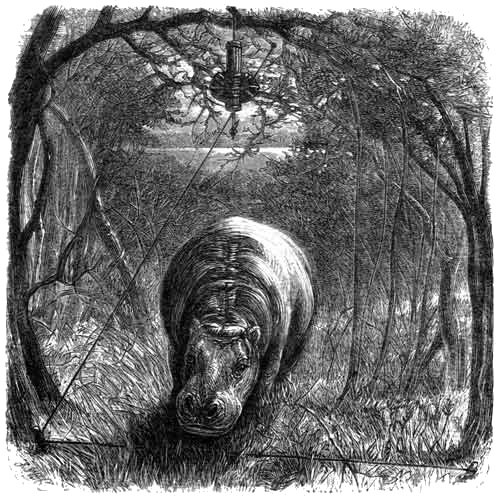
HIPPOPOTAMUS AND TRAP.
"His nose pierceth through snares."—Job xl. 24.
The drop-trap is a log of wood, weighted with stones, and having at one end an iron spike, which is sometimes poisoned. The path which the animal takes is watched, a conveniently overhanging branch is selected, and from that branch the cruel spear is suspended, by a catch or trigger, exactly over the centre of the path. There is no difficulty in finding the precise centre of the path, owing to the peculiar gait of the animal, which has already been described. One end of the trigger supports the spear, and to the other is attached a rope, which is brought across the path in such a way that when touched it relieves the spear, which is driven deeply into the animal's back. If well hung, the spear-blade divides the spine, and the wounded animal falls on the spot, but, even if it should miss a vital part, the poison soon does its fatal work.
In consequence of the continual persecution to which it is subjected, the hippopotamus becomes exceedingly wary, and, huge, clumsy, and blundering as it looks, is clever enough to detect either pitfall or drop-trap that have not been contrived with especial care. An old and experienced hippopotamus becomes so wary that he will be suspicious even of a bent twig, and, rather than venture across it, he will leave the path, force for himself a roundabout passage, and return to the path beyond the object that alarmed him.
Mr. T. Baines, to whose sketches I am indebted for the illustration, told me that the hippopotamus is possessed of much more intellect than might be expected from a creature of so dull, clumsy, and unpromising aspect. Apathetic it generally is, and, as long as it is left unmolested, does not care to molest even the human beings that intrude upon its repose.
It likes to lie in the shade of the reeds and rushes, and may be seen floating in the water, with only the nostrils, the eyes, and the ears above the surface, these organs being set in a line along the head, evidently for the purpose of allowing the whole body to be hidden under water while the three most important senses are capable of acting.
A canoe-man who knows the habits of the hippopotamus will fearlessly take his fragile vessel through a herd of the animals, knowing that, if he only avoids contact with them, they will not interfere with him. The only danger is, that a hippopotamus may rise under the canoe, and strike itself against the boat, in which case the animal is rather apt to consider the intruding object as an enemy, and to attack it, sometimes crushing the canoe between its teeth, and mostly upsetting it, and throwing the crew into the water. In such a case, the men always dive at once to the bottom of the river, and hold on to some weed or rock as long as they can exist without breathing. The reason for this proceeding is, that the hippopotamus always looks for its enemy upon the surface of the water, and, if the men were to swim to shore, they would be caught and killed before they had swum many strokes. But, as it sees nothing but the damaged canoe, its short-lived anger vanishes, and it sinks again into the river, leaving the men at liberty to regain and repair their vessel.
There is one passage in the description of the Behemoth which requires a few words of explanation: "He moveth his tail like a cedar" (v. 17).
Several commentators have imagined that this expression shows that the Behemoth must have been an animal which had a very long and powerful tail, and have adduced the passage as a proof that the crocodile was the animal that was signified by the Behemoth. Others, again, have shifted the position of the tail, and, by rendering it as the "proboscis," have identified the Behemoth with the elephant. There is, however, no necessity for straining the interpretation, the passage evidently signifying that the member in question is stiff and inflexible as the cedar-stem.
BIRDS
THE LÄMMERGEIER, OR OSSIFRAGE OF SCRIPTURE
Difficulty of identifying the various birds mentioned in Scripture—The vultures of Palestine—The Lämmergeier, or Ossifrage of Scripture—The Hebrew word Peres, and its signification—The Ossifrage, or Bone-breaker—Appearance of the Lämmergeier—Its flight and mode of feeding—How the Lämmergeier kills snakes and tortoises, and breaks marrow-bones—Mode of destroying the chamois and mountain sheep—Nest of the Lämmergeier.
It has already been mentioned that even the best Biblical scholars have found very great difficulties in identifying several of the animals which are named in Scripture. This difficulty is greatly increased when we come to the Birds, and in many instances it is absolutely impossible to identify the Hebrew word with any precise species. In all probability, however, the nomenclature of the birds is a very loose one, several species being classed under the same title.
Even at the present day, the English language presents many similar instances of poverty, as is well known to all zoologists. Taking the birds as our first examples, how often do we not find the same word used to signify many distinct species, and, again, one species designated by several dissimilar words? The word Vulture, for example, is used to signify a great number of birds, including the Lämmergeier, the Condors, the Griffons, the Caracaras, and others; while the term Eagle has scarcely a less wide signification. Sometimes the name is applied in such a manner as to mislead those who are not scientific ornithologists, and we find such inappropriate titles as night-hawk, fern-owl, hedge-sparrow, reed-wren, &c., the birds in question being neither hawks, owls, sparrows, nor wrens.
Keeping this difficulty in mind, I shall mention all the species which are likely to have been classed under a single title, giving a general description of the whole, and a detailed account of the particular species which seems to answer most closely to the Hebrew word.
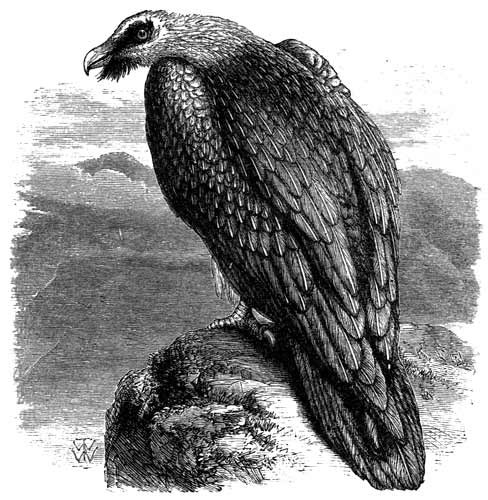
THE LÄMMERGEIER, OR OSSIFRAGE OF SCRIPTURE.
"These are they of which ye shall not eat: the eagle, and the ossifrage, and the ospray."—Deut. xiv. 12.
Following the arrangement which has been employed in this work, I shall begin with the bird which has been placed by zoologists at the head of its class, namely, the Lämmergeier, the bird which may be safely identified with the Ossifrage of Scripture. The Hebrew word is "Peres," a term which only occurs twice when signifying a species of bird; namely, in Lev. xi. 13, and the parallel passage in Deut. xiv. 12. The first of these passages runs as follows: "These ye shall have in abomination among the fowls; they shall not be eaten, they are an abomination: the eagle, and the ossifrage, and the ospray." The corresponding passage in Deuteronomy has precisely the same signification, though rather differently worded: "These are they of which ye shall not eat: the eagle, and the ossifrage, and the ospray."
The reader will here notice that the sacred narrative gives no account of the appearance or habits of the bird, but merely classed it with the remainder of the predacious birds, all of which are declared to be unfit for food. We must therefore look for some assistance in the etymology of the word peres, which signifies one who breaks anything. The same word occurs in several other passages of Scripture.
For example, the word was much used by David in commemorating any remarkable event. When David sent Uzzah and Ahio to fetch the ark from Kirjath-jearim, the oxen which drew the cart stumbled and shook the ark, so that it seemed likely to fall. Uzzah, who walked by the side of the cart, while his brother marched in front of the oxen, instinctively put out his hand to uphold it, and fell dead by the side of the ark which he had touched without authority. In order to commemorate this event, David called the spot whereon it occurred Perez-Uzzah, or the Breaking of Uzzah, "because the Lord had made a breach upon Uzzah." (See 2 Sam. vi. 8.)
Reference to this event was afterwards made by David when he brought the ark into Jerusalem. Having taken warning by the solemn event which he had witnessed, he called together the priests and Levites, to whom he gave the commission to bring the ark with due honour, and "said unto them, Ye are the chief of the fathers of the Levites: sanctify yourselves, both ye and your brethren, that ye may bring up the ark of the Lord God of Israel unto the place that I have prepared for it.
"For, because ye did it not at the first, the Lord our God made a breach (peres) upon us, for that we sought Him not in due order" (1 Chron. xv. 12, 13). David again employed the word to signify the breaking up or destruction of the Philistines. "David smote them there, and said, The Lord hath broken forth upon mine enemies before me, as the breach of waters. Therefore he called the name of that place Baal-perazim"—i.e.
the Place of Breakings. The same word occurs again in that dread message to Belshazzar, written by the hand upon the wall, "Mene, mene, tekel, upharsin," or peres, the last word signifying that the kingdom was broken up, and would be given to other rulers.
The word peres, then, signifies a breaker; and the Latin term Ossifraga, or Bone-breaker, is a very good translation of the word. How it applies to the Lämmergeier we shall presently see.
The Lämmergeier belongs to the vultures, but has much more the appearance of an eagle than a vulture, the neck being clothed with feathers, instead of being naked or only covered with down. It may at once be known by the tuft of long, hair-like feathers which depends from the beak, and which has gained for the bird the title of Bearded Vulture. The colour of the plumage is a mixture of different browns and greys, tawny below and beautifully pencilled above, a line of pure white running along the middle of each feather. When young it is nearly black, and indeed has been treated as a separate species under the name of Black Vulture.
It is one of the largest of the flying birds, its length often exceeding four feet, and the expanse of its wings being rather more than ten feet. In consequence of this great spread of wing, it looks when flying like a much larger bird than it really is, and its size has often been variously misstated. Its flight, as may be imagined from the possession of such wings, is equally grand and graceful, and it sweeps through the air with great force, apparently unaccompanied by effort.
The Lämmergeier extends through a very large range of country, and is found throughout many parts of Europe and Asia. It is spread over the Holy Land, never congregating in numbers, like ordinary vultures, but living in pairs, and scarcely any ravine being uninhabited by at least one pair of Lämmergeiers.
The food of the Lämmergeier is, like that of other vultures, the flesh of dead animals, though it does not feed quite in the same manner that they do. When the ordinary vultures have found a carcase they tear it to pieces, and soon remove all the flesh. This having been done, the Lämmergeier comes to the half-picked bones, eats the remaining flesh from them, and finishes by breaking them and eating the marrow. That a bird should be able to break a bone as thick and hard as the thigh-bone of a horse or ox seems rather problematical, but the bird achieves the feat in a simple and effectual manner.
Seizing the bone in its claws, it rises to an immense height in the air, and then, balancing itself over some piece of rock, it lets the bone fall, and sweeps after it with scarce less rapidity than the bone falls. Should the bone be broken by the fall, the bird picks the marrow out of the fragments; and should it have escaped fracture by reason of falling on a soft piece of ground instead of a hard rock, the bird picks it up, and renews the process until it has attained its object. It will be seen, therefore, that the name of Ossifrage, or Bone-breaker, may very properly be given to this bird.
Not only does it extract the marrow from bones in this peculiar manner, but it procures other articles of food by employing precisely the same system. If it sees a tortoise, many of which reptiles are found in the countries which it inhabits, it does not waste time and trouble by trying to peck the shell open, but carries its prey high in the air, drops it on the ground, and so breaks its shell to pieces. Tortoises are often very hard-shelled creatures, and the Lämmergeier has been observed to raise one of them and drop it six or seven times before the stubborn armour would yield. Snakes, too, are killed in a similar manner, being seized by the neck, and then dropped from a height upon rocks or hard ground. The reader may perhaps be aware that the Hooded Crow of England breaks bones and the shells of bivalve molluscs in a similar manner.
Mr. Tristram suggests, with much probability, that the "eagle" which mistook the bald head of the poet Æschylus for a white stone, and killed him by dropping a tortoise upon it, was in all likelihood a Lämmergeier, the bird being a denizen of the same country, and the act of tortoise-dropping being its usual mode of killing those reptiles.
We now see why the Lämmergeier is furnished with such enormous wings, and so great a power of flight, these attributes being needful in order to enable it to lift its prey to a sufficient height. The air, as we all know, becomes more and more attenuated in exact proportion to the height above the earth; and did not the bird possess such great powers of flight, it would not be able to carry a heavy tortoise into the thinner strata of air which are found at the height to which it soars.
The instinct of killing its prey by a fall is employed against other animals besides snakes and tortoises, though exerted in a somewhat different manner. The bird, as has already been mentioned, lives among mountain ranges, and it may be seen floating about them for hours together, watching each inch of ground in search of prey. Should it see a goat or other inhabitant of the rocks standing near a precipice, the Lämmergeier sweeps rapidly upon it, and with a blow of its wing knocks the animal off the rock into the valley beneath, where it lies helplessly maimed, even if not killed by the fall.
Even hares and lambs are killed in this manner, and it is from the havoc which the Lämmergeier makes among the sheep that it has obtained the name of Lämmergeier, or Lamb-Vulture. So swift and noiseless is the rush of the bird, that an animal which has once been marked by its blood-red eye seldom escapes from the swoop; and even the Alpine hunters, who spend their lives in pursuit of the chamois, have occasionally been put in great jeopardy by the sudden attack of a Lämmergeier, the bird having mistaken their crouching forms for the chamois, and only turned aside at the last moment.
The reason for employing so remarkable a mode of attack is to be found in the structure of the feet, which, although belonging to so large and powerful a bird, are comparatively feeble, and are unable, like those of the eagle, to grasp the living animal in a deadly hold, and to drive the sharp talons into its vitals. They are not well adapted for holding prey, the talons not possessing the hook-like form or the sharp points which characterise those of the eagle. The feet, by the way, are feathered down to the toes. The beak, too, is weak when compared with the rest of the body, and could not perform its work were not the object which it tears previously shattered by the fall from a height.
The nest of the Lämmergeier is made of sticks and sods, and is of enormous dimensions. It is almost always placed upon a lofty cliff, and contains about a wagon-load or so of sticks rudely interwoven, and supporting a nearly equal amount of sods and moss.
An allied species lives in Northern Africa, where it is called by a name which signifies Father Longbeard, in allusion to the beard-like tufts of the bill.
THE EGYPTIAN VULTURE OR GIER-EAGLE
The Râchâm or Gier-Eagle identified with the Egyptian Vulture—Its appearance on the Egyptian monuments—Signification of the word Râchâm—Various translations of the word—The shape, size, and colour of the bird—Its value as a scavenger, and its general habits—The Egyptian Vultures and the griffons—Its fondness for the society of man—Nest of the Egyptian Vulture.
In the same list of unclean birds which has already been given, we find the name of a bird which we can identify without much difficulty, although there has been some little controversy about it. This is the so-called Gier-Eagle, which is named with the cormorant and the pelican as one of the birds which the Jews are forbidden to eat. The word which is translated as Gier-Eagle is Râchâm, a name which is almost identical with the Arabic name of the Egyptian Vulture, sometimes called Pharaoh's Chicken, because it is so often sculptured on the ancient monuments of Egypt. It is called by the Turks by a name which signifies White Father, in allusion to the colour of its plumage.
Before proceeding to a description of the bird, we will examine the other interpretations which have been given to the word râchâm.
In the first place, the word signifies "love," and is used in that sense in many passages of Scripture. According to Buxtorf, the bird in question is the merops or bee-eater, "a bird so called from the love and pity which is shown to its parents, because it nurtures them when hidden in the most lofty caves." Some of the Talmudists take it to be the woodpecker.
Another rendering of the word which has received much favour is, that the Râchâm is the hyacinthine gallinule, or sultana hen (Pophyrio veterum). This bird is allied to the rails, and is remarkable for the great length of its toes, by means of which it can walk on floating herbage as it lies on the surface of the water. The colour of the bird is a rich and variable blue, darker on the back and lighter on the throat and breast. It is on account of this purple hue that the bird has received the name of Porphyrio, or Purple Bird. It is spread over many parts of Asia, Africa, and Europe.
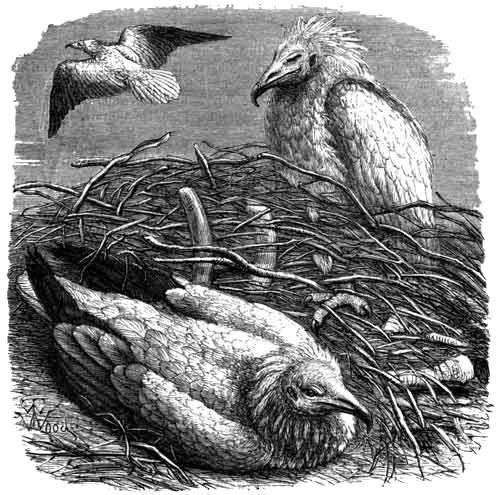
EGYPTIAN VULTURE, OR GIER-EAGLE.
"And the pelican, and the gier-eagle, and the cormorant."—Deut. xiv. 17.
The reading of râchâm as porphyrio is followed in the Septuagint, and the reading has been defended on the ground that the bird must belong to the aquatic group, being placed between the pelican and cormorant. The Jewish Bible follows our version, but affixes the mark of doubt to the word.
Although some of the Talmudists render the word as woodpecker, others identify it with the Egyptian Vulture. In Lewysohn's "Zoologie des Talmuds," there is a curious speculation on this subject. This bird, according to the authors whom he quotes, is the Schirkrek, and derives its name from its peculiar cry, which begins with a hiss (Schirk) and ends with a shriek (Rek). The bird utters its cry when the rising of the Nile is expected, and so has earned the name of Râchâm, or Love, this word being frequently used in the Scriptures as a metaphor for rain, dew, or any water that nourishes plants.
Without adopting the process of reasoning employed in this case, we may safely accept the conclusion, and consider the Râchâm as identical with the Egyptian Vulture (Neophron perenopterus).





